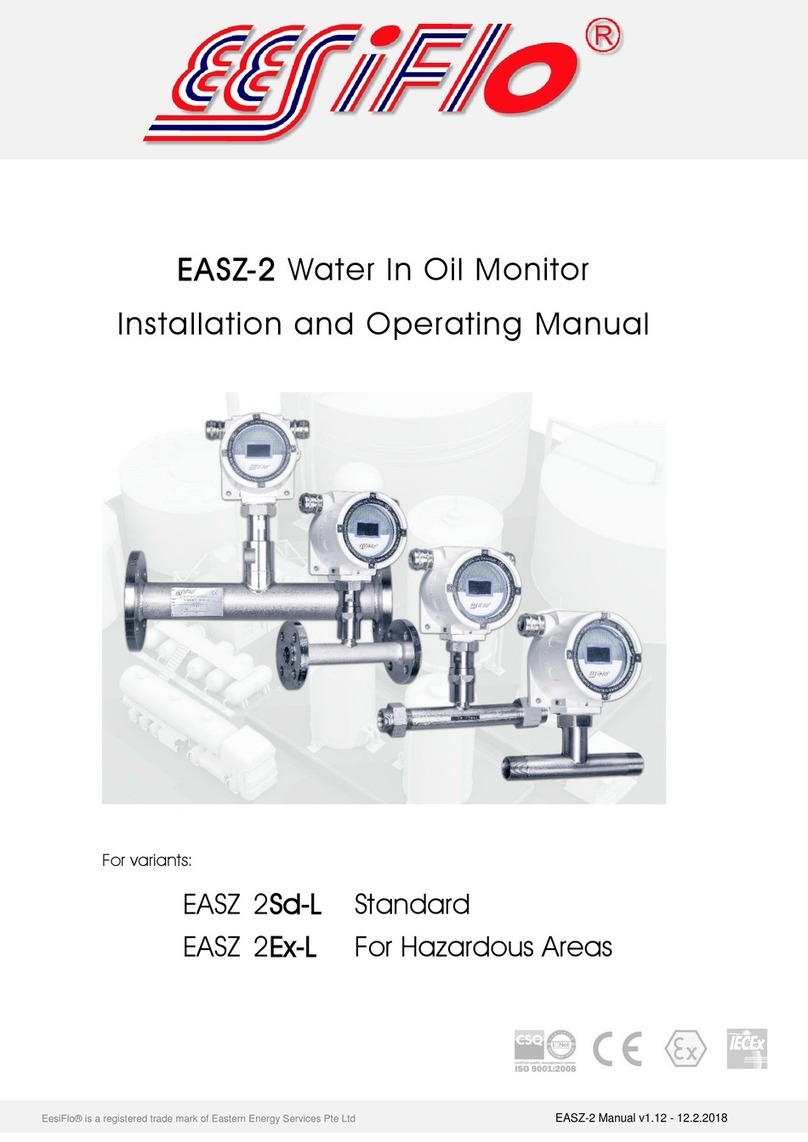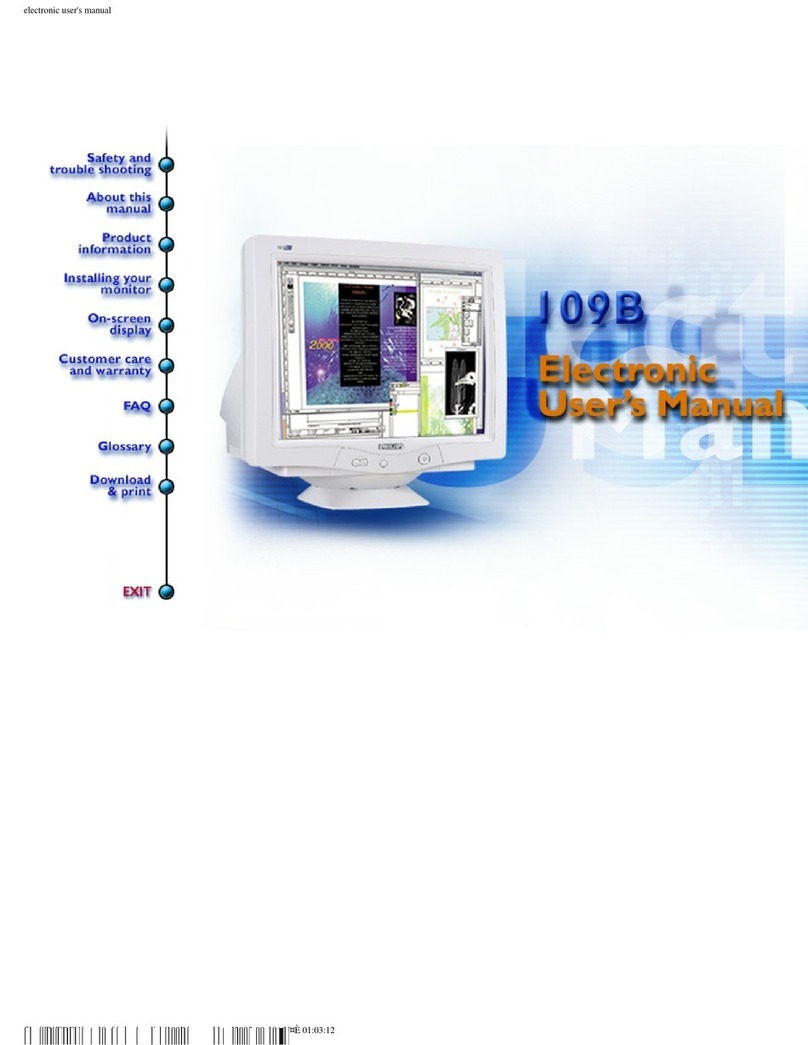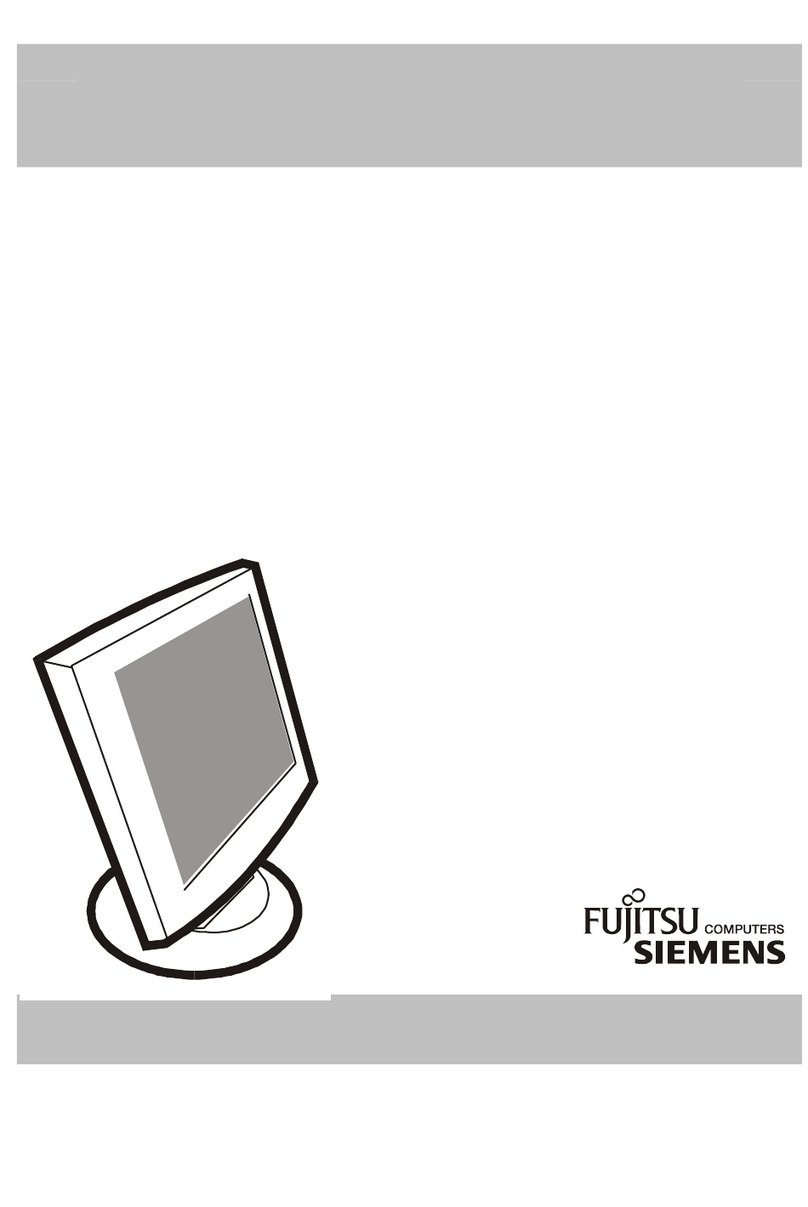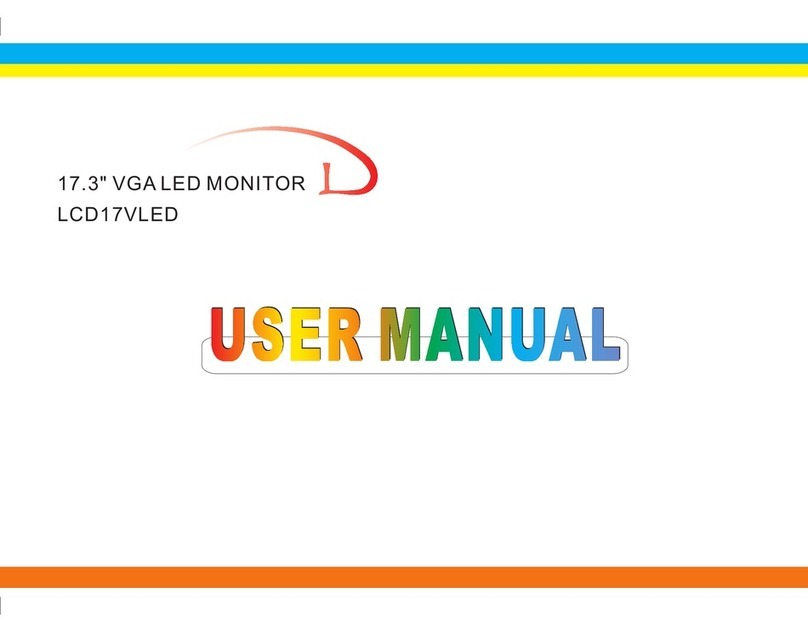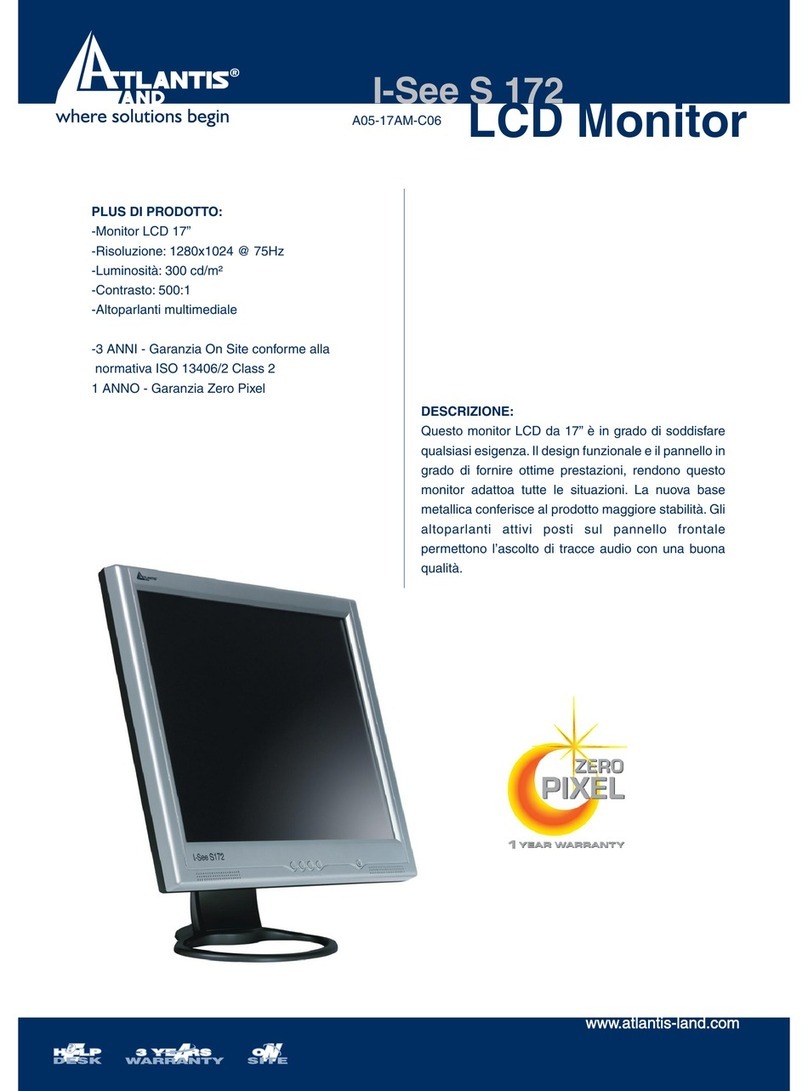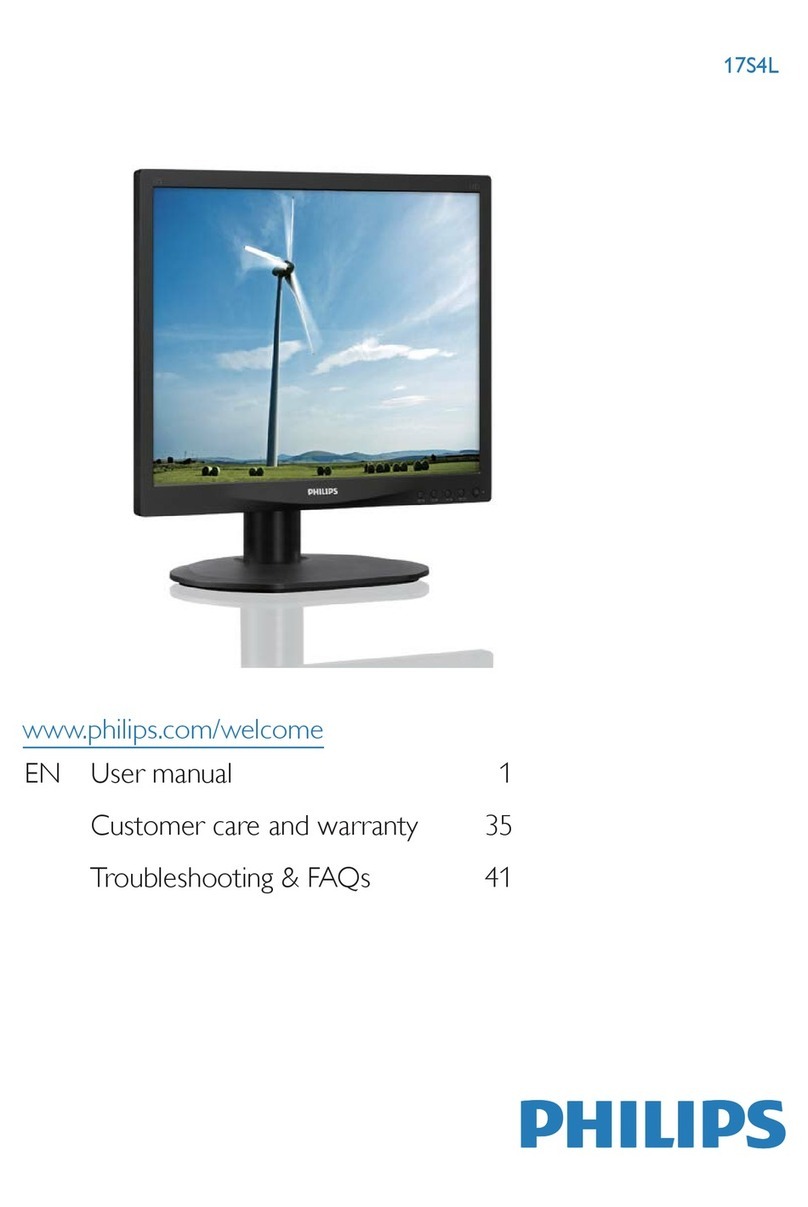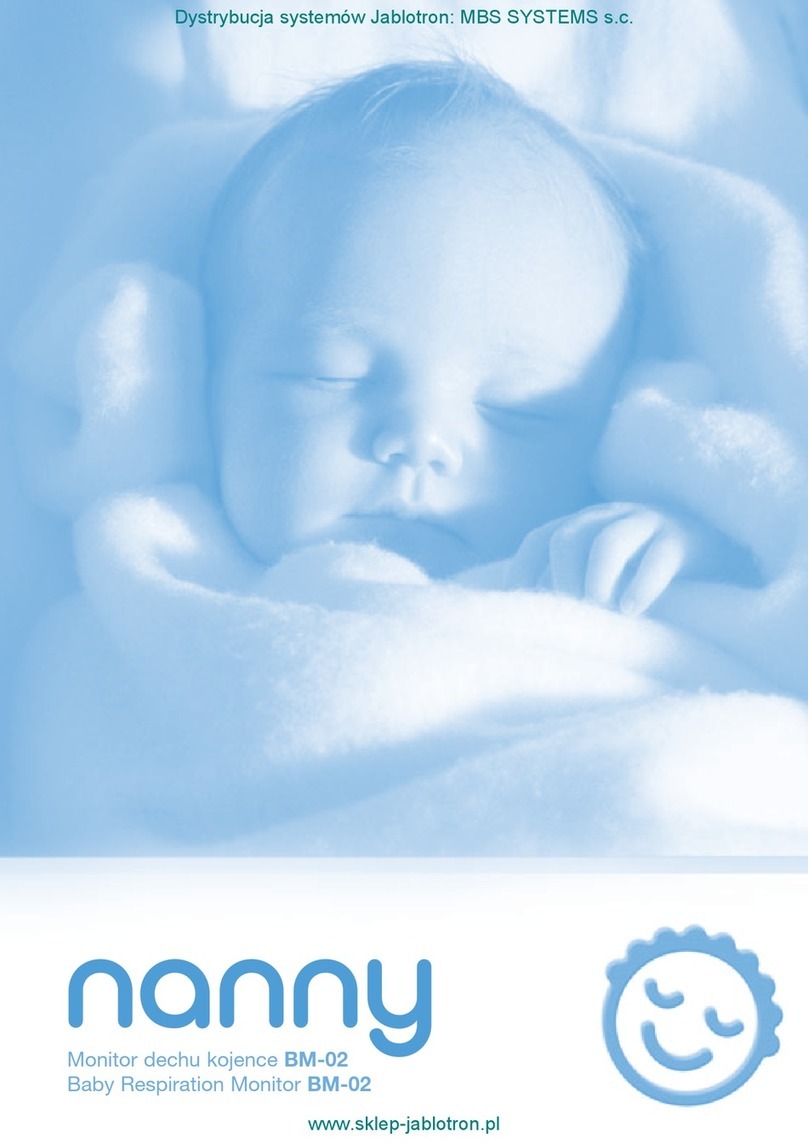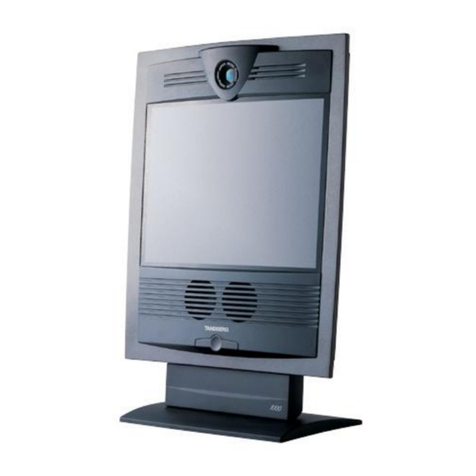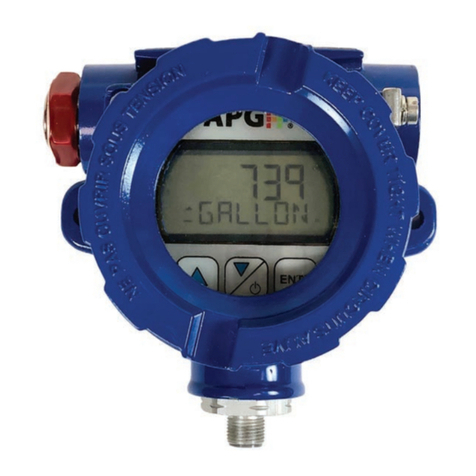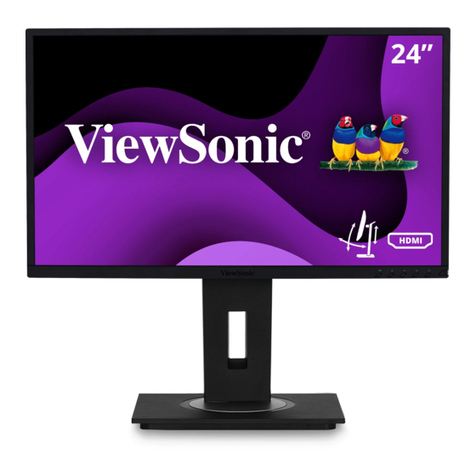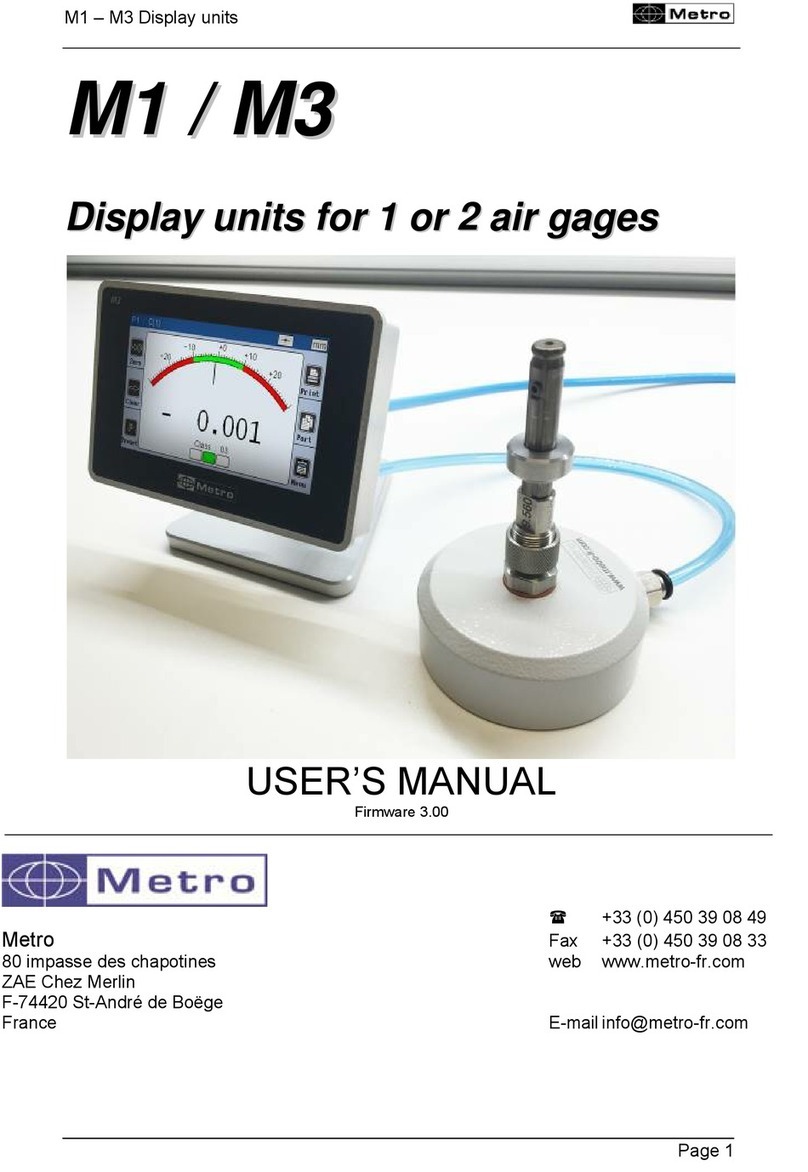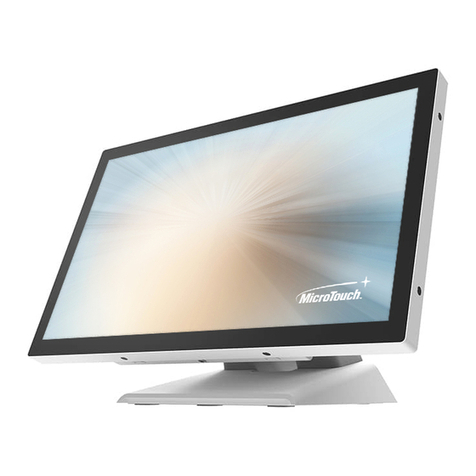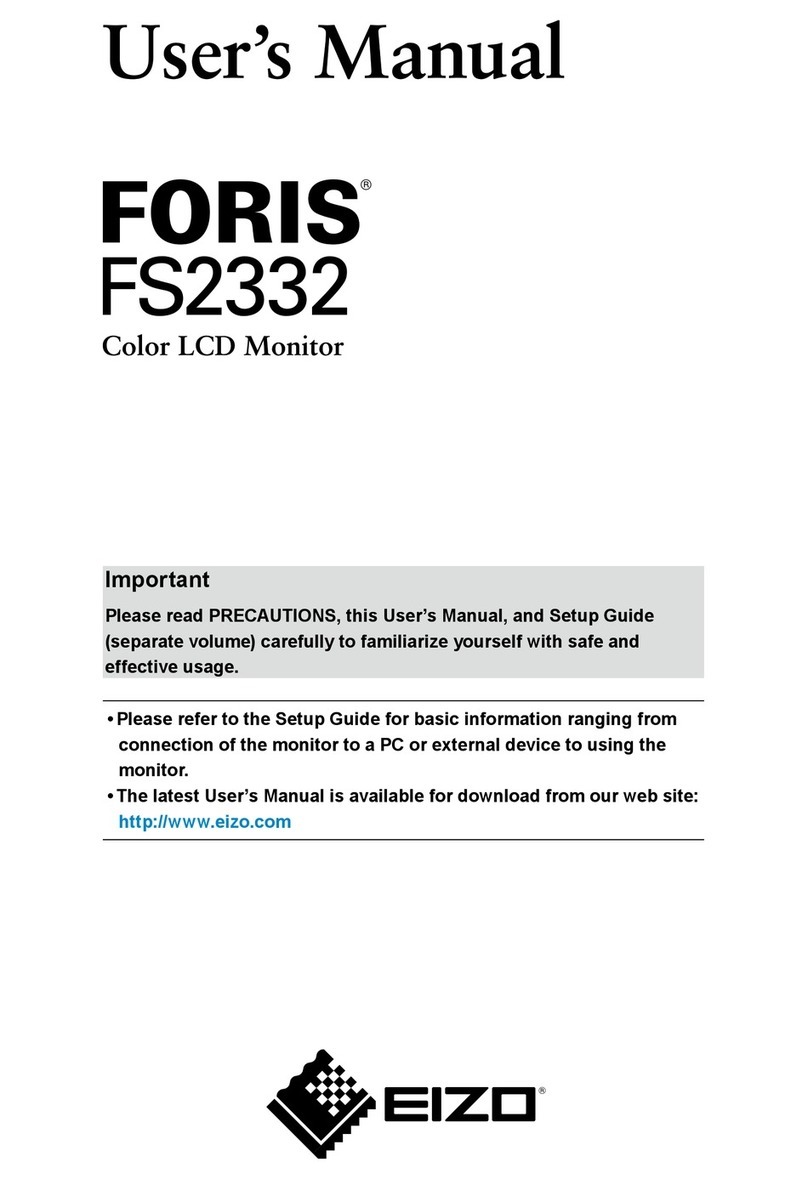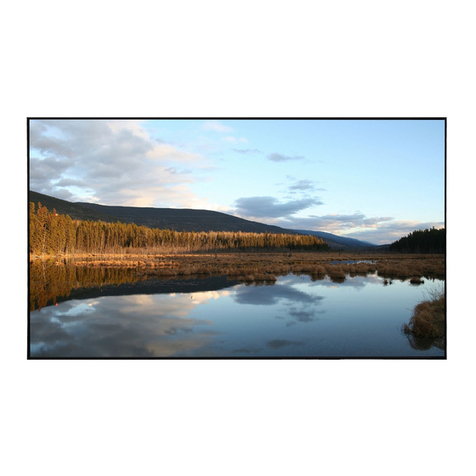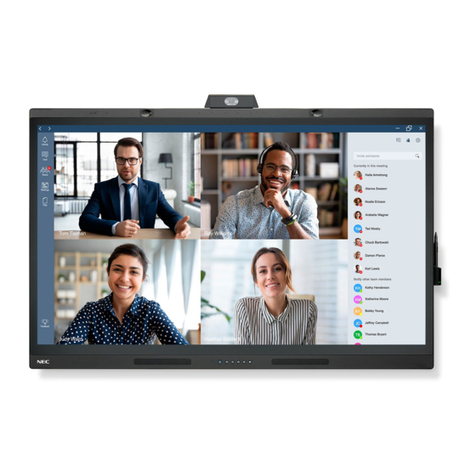EESiFlo EASZ-1 User manual

2| 48
EESIFLO® is a US registered trademark serial number 77071229
Standard Range EASZ-1
Measuring Worldwide
1.ATEX/ IECEx/ CSA –For Hazardous Areas ...................................................................................... 3
± WARNING...................................................................................................................................... 5
Read Me First .................................................................................................................................... 6
Introduction ................................................................................................................................... 7
•General Specifications .......................................................................................................... 8
•ATEX Specifications............................................................................................................... 9
•Data Plates............................................................................................................................ 9
Basic Measurement Principle ......................................................................................................... 10
•Typical Measurement Scenario ........................................................................................... 11
•Standard Range VS High Range ........................................................................................... 12
Instrument Overview...................................................................................................................... 13
•Dimensions......................................................................................................................... 13
•Handling ............................................................................................................................. 13
Wiring............................................................................................................................................. 14
•Grounding Your Plumbing................................................................................................... 14
•J7-RS-232 Connector........................................................................................................... 14
•Cable Paths......................................................................................................................... 15
•Grounding/ Isolation.......................................................................................................... 16
•Static Electricity .................................................................................................................. 17
Installation...................................................................................................................................... 18
•Mounting............................................................................................................................ 18
•Optional: Static Mixer, Thermal Insulation Box and Sunshade ............................................. 19
The Effects of Air, Gas and Chemicals .............................................................................................. 20
Sampling Point ................................................................................................................................ 21
Safely Connecting to the EASZ-1...................................................22
Ensuring Galvanic Isolation.............................................................................................................. 22
RS-232 Communication................................................................................................................... 23
•List of Commands ............................................................................................................... 25
A Typical Calibration Scenario using RS-232..................................................................................... 28
•Zero Calibration .................................................................................................................. 29
•Percent Calibration ............................................................................................................. 29
Temperature Coefficient Procedure .................................................................................... 30
•Custom Calibration ............................................................................................................. 31
•Laboratory Calibration ........................................................................................................ 32
Communication Through the HART Modem................................................................................... 33
Wiring Configuration for the HART Modem ..................................................................................... 33
•Galvanic Isolation Barriers................................................................................................... 34
Installing The EESIFLO Software for HART Communication............................................................... 35
How to do 4-20mA Trim? ............................................................................................................... 40
Understanding the Functions of the HART Software ........................................................................ 41
•Calibration Parameters ....................................................................................................... 43
•To Calibrate for a Percentage.............................................................................................. 44
Standalone HART Communicator .................................................................................................... 46
•Resetting HART Poll Address .............................................................................................. 46
•Universal HART Commands ................................................................................................ 46
Warranty ........................................................................................................................................ 47
Table of Contents

3| 48
EESIFLO® is a US registered trademark serial number 77071229
Standard Range EASZ-1
Measuring Worldwide
Hazardous Area Versions
Safety Precautions (Hazardous Area Versions)
✓You must carefully read all the instructions in this manual. You must not start the installation
before taking these instructions into account.
✓This equipment might receive some hazardous voltages. If you do not consider taking these
instructions seriously, you may risk facing serious injuries.
✓Before setting up your installation, check the model suits your application. The wiring of this
equipment must comply with regulations and be executed by qualified personnel.
Start up Instructions (Hazardous Area Versions)
•FUNCTION: The EASZ-1 Water In Oil Monitor (Water-Cut / BS&W) is aimed at measuring water
content in hydrocarbon liquids. The equipment delivers a 4-20 mA signal proportional to the
measured water content.
•ATEX MARKING MEANING AND ATEX INSTALLATION ZONES: refer to the following page
•INSTALLATION
✓Location: This equipment can be installed in defined explosive atmospheres and is in
compliance with the 94/9/EC ATEX directive. The surface temperature must not exceed that
indicated by the label.
✓Fixing and mounting: The housing must be protected against mechanical shocks. No drilling or
machining must be done. Make sure the cable gland is appropriately tightened and make a
loop with your cable to avoid running water alongside. If you do not take these precautions
into account, the envelope certification will be at risk and the ingress of protection of the
housing might be invalidated.
✓Electrical wiring:Electrical wiring must be executed when DE-ENERGIZED after mounting and
fixing the instrument. Electrical wiring must be executed with respect to sound engineering
practices and enforced norms. Cables must be of the shielded type. In order to guarantee a
perfect tightness, the cable gland should be screwed with an appropriate spanner. Terminal
wiring is designed for 1.5mm² wires.
✓Cable paths: The type and the path of cables (I.S. cables) must comply with regulations. Careful
precautions must be taken to avoid electromagnetic coupling with other cables capable of
causing hazardous voltages or currents. Cables and wires must be protected against any
damage.
✓Specials conditions for a safe use: refer to the following pages.
✓SETTING: Setup can be done using the serial link cable or using a HART interface. Setup using
the serial cable is only to be done in safe zone. HART can be used in hazardous areas provided
a HART terminal with appropriate certification is used.
Maintenance (Hazardous Area Versions)
•Precautions to be observed during maintenance.
✓The dismantling of the equipment must be executed when DE-ENERGIZED.
✓EESIFLO guarantees the certification of the equipment Ex-Works. Any operation other than
software changes will rule out EESIFLO’s responsibility in case of failure. If a fault is suspected
or observed, the equipment must be checked / repaired only by authorized personnel or
returned to our service department.
CONTACT US
•Updated EC type Examination Certificates can be obtained by contacting us at
www.eesiflo.com
ATEX / IECEx / CSA
INSTRUCTION MANUAL
Water In Oil Monitor

4| 48
EESIFLO® is a US registered trademark serial number 77071229
Standard Range EASZ-1
Measuring Worldwide
ATEX - Details (Hazardous Area Versions)
ATEX CERTIFIED INSTRUMENT
Ex ia I/IIB T4(-20°C < Ta + < +60°C) 2575 I M1/II 1G
MARKING DETAILS
Manufacturer
EESIFLO International Pte Ltd 60 Kaki Bukit Place
#02-19 Eunos Techpark
Singapore 415979
Instrument type
EASZ-1 Water in Oil Monitor
ATEX protection
Intrinsic safety (according to EN 50014 –50020)
Housing protection
IP 66 to EN 60529
EC examination type
ITS06ATEX25406X
Marking
Ex ia I/IIB T4 (-20°C< Ta + < +60°C) 2575 I M1/II 1G
For zones
0/1/2 for gas of groups: IIB (according to EN60079-10)
Equipment category
Surface temperature 135°C (T4) at ambient
Special Conditions For Safe Use (Hazardous Area Versions)
Hazardous Area Versions must only be connected
to intrinsically safe certified equipment. This
association must be compatible to the intrinsic
safety rules. The electrical parameters of this
equipment must not exceed the values indicated in
the “Electrical Parameters” table.
The ambient temperature of use must never be
outsidetherange of class T4 (-20°C < Ta + < +60°C)
The surface temperature of the device (indicated
on the device) must never be exceeded. This temperature must take into account both ambient and
fluid temperatures. The installation of equipment in zone 0 must comply with the EN 60079-14 norm
and, in particular § 12.
The electrical connection of Water in Oil Monitors with output cable must comply with the EN 50020
(1994) norm and, in particular § 6.1.
Particular Recommendations (Hazardous Area Versions)
Make sure the cable gland is appropriately tightened. If you do not take these precautions into
account, the envelope certification would be put at risk, and the index of protection of the housing
might be compromised.
The EASZ-1 shall not be used with Zener barriers. Only IS barriers of the isolator/galvanic type shall be
used.
Electrical parameters
Ui (V)
≤28 V
Ii (mA)
≤93 mA
Pi (W)
≤0.66 W
Ci
237 μF (at 7.2Vdc) or
110 nF (at 28Vdc)
Li
0 μH

5| 4 8
Measuring Worldwide
EESIFLO® is a US registered trademark serial number 77071229
Standard Range EASZ-1
•99% of all problems with your EASZ-1 will result from incorrect wiring.
•The EASZ-1 must be installed on an isolated 4-20 mA current loop.
•If your wiring is grounded or shared with any other device, your EASZ-1 WILL NOT WORK.
•The recommended wiring for the EASZ-1 begins on page 14 of this manual.
•If you have any questions, please contact EESIFLO before beginning your installation.
Before Installing Your EASZ-1

6| 4 8
Measuring Worldwide
EESIFLO® is a US registered trademark serial number 77071229
Standard Range EASZ-1
Read Me First
EESIFLO throughout this manual shall not be held liable for technical or editorial errors or omissions
in this manual.
EESIFLO makes no warranties other than those detailed below, express or implied, including the
implied warranties of merchantability and fitness for a particular purpose with respect to this manual
and, in no event, shall EESIFLO be liable for any special or consequential damages including, but not
limited to, loss of production, loss of profits, etc.
The contents of this manual are presented for educational purposes only, and while every effort has
been made to ensure accuracy, these instructions are not to be construed as warranties or guarantees,
expressed or implied, regarding the products or services described herein or their use or applicability.
EESIFLO reserves the right to modify or improve the designs or specifications of our products at any
time. EESIFLO does not assume responsibility for the selection, use or maintenance of any product,
which remains the sole responsibility of the purchaser and end-user.
All rights to this manual are reserved. No part of this work may be reproduced or copied in any form
without written permission from EESIFLO.

7| 4 8
Measuring Worldwide
EESIFLO® is a US registered trademark serial number 77071229
Standard Range EASZ-1
Introduction to EASZ-1
The EASZ-1 is an Online Water in Oil Monitor which has been designed to fit in a piping system and to
measure the water content in an oil when there is a positive flow. The measurement works correctly
only with a positive flow, unlike a laboratory instrument that will measure the water content of oil in
a static condition. All wet calibrations of the instrument must be conducted while liquid is flowing
through the unit and the liquid must be well-mixed.
Flow loop showing positive flow.
There are several reasons why the EASZ-1 requires a minimum flow to operate. Although it is capable
of giving a reading in a static condition (no flow) it is important to understand that oil and water
separate very quickly, and this separation may cause errors in the measurement. Water and oil do not
easily mix but they begin to mix in a flowing stream, especially when they have to go through or around
obstacles or if energy is applied. It is the responsibility of the user to ensure that the water and oil are
well mixed in the pipe to obtain best results.

8| 4 8
Measuring Worldwide
EESIFLO® is a US registered trademark serial number 77071229
Standard Range EASZ-1
General Specifications
Operating Principle
Dielectric Constant/ Capacitance
Supply Voltage
12…24 V DC, 2 Wire Loop-Powered
Power Consumption
0.66 Watts
Output/Digital Protocol
4…20mA, HART
RS232 Full Duplex
Compatible with Universal HART®
Setup and Calibration
EASZ-1 GUI Software for Windows® PC
Connection Via USB-RS232 Comm. Cable (Optional: HART Modem Cable)
Typical Accuracy
Parameters
Low Range
Mid Range
High Range
Full Range
Measuring range
0…5%
0…25%
0… Inversion
80…100%
0…100%
Accuracy
± 0.02
± 0.03
± 0.50
± 0.2
See EASZ-2
*Values are typical and do not represent every situation.
Electronics Enclosure
Stainless Steel 316, IP66
Ambient Temperature
-20°C…60°C (-4°F…140°F)
Response Time
1 second nominal (no averaging applied)
1…20 second programmable averaging time
Start-Up Time
≤ 20 Seconds
Remote Display
Panel or Field Type (galvanically isolated)
Process Temperature
Up to 130°C (266°F)
Process Pressure
Up to 100 Bar (1,450 Psi), higher pressure consult EESIFLO with process information.
Connection Size
DN25…DN600 (1” Inch…24” Inch), larger sizes consult EESIFLO with process information.
Process Connection
NPT, BSP, ANSI flanges, PN flanges, JIS flanges
Body & Sensing Element Construction Material
Stainless Steel 316/316L (Standard), NACE Compliant.
Optional Duplex, Monel, Hastelloy and more upon request
Seals and Spacers
Teflon and Polyether Ether Ketone (PEEK)
Installation
Inline or bypass setup, (Optional: integral with dual element static mixer)
Approvals
Intrinsic Safety (IS) ATEX, IECEx, CSA
CE Mark

9| 4 8
Measuring Worldwide
EESIFLO® is a US registered trademark serial number 77071229
Standard Range EASZ-1
ATEXSPECIFICATION (Standard Range Unit)
EASZ-1
Ex Version Only
Production
II 1 G Ex ia
ITS06ATEX25406x/4
Certificate
Detailed when certification officially provided
Power Supply
2 wire 24Vdc
Data Plates
The information on the data plates must always be clearly visible at all times. Data plates must be
protected from any damage. In the event of damage, the Ex-certification will be compromised,
immediately contact the manufacturer to coordinate and authorize repairs.
Data plates will be updated to comply with any certification updates or additions.
The data plates clearly describe the product type, serial number, manufacturer, and information in
regard to electrical safety for hazardous area applications. If the unit is not being used in a hazardous
area, the information will be more general.

10 | 4 8
Measuring Worldwide
EESIFLO® is a US registered trademark serial number 77071229
Standard Range EASZ-1
Basic Principle of Measurement
The EASZ-1 measurement units are in in picofarads (pF) A picofarad is a unit used to measure
capacitance i.e., the ability of a system to store an electric charge.
Measurement of Capacitance between 2 plates
Instead of measuring the capacitance between 2 plates, the EASZ-1 is measuring the capacitance
between 2 pipes. The mechanical measurement section consists of 2 pipes, an inner and outer pipe.
The EASZ-1 measures the ability of the liquid to store energy while passing through these 2 pipes.

11 | 4 8
Measuring Worldwide
EESIFLO® is a US registered trademark serial number 77071229
Standard Range EASZ-1
TypicalMeasurementScenario (Low Range Unit only)
Graph showing a Picofarad (pF) Increase in oils of differing
density as water content increases (1-inch EASZ-1)
The EASZ-1 is not limited to measuring only water in oil. It is a device that can measure the
concentration of one type of liquid in another. However, there must be a very big difference in the
dielectric constant of the liquids in order for a meaningful measurement. In the case of most oils, we
see that the dielectric constant is around 2 while the dielectric constant of water is about 80 at room
temperature.
Liquid Type
Dielectric Constant (DC) @20 °C
Benzene
2.28
Diesel
2.1 to 2.4
Petroleum
2.1 to 2.4
Crude Oil
2.1 to 2.4
Acetylene
2.48
Coconut (Refined)
2.9
Kerosene
1.8
Naptha
2.5
Palm Seed Oil
1.8
Xylene
2.0
If the above low dielectric liquids have water added to them, there will be a significant increase in the
picofarad readings. It only takes a small increase in water content to see the change. The EASZ-1 has
not been designed to measure concentrations of water in liquids that possess a high dielectric
constant e.g., Methanol- which has a dielectric constant of 33. For measurements of water content in
higher dielectric constant liquids, contact EESIFLO.
a. Capacitance: 179.8pF H2O: 0%
b. Capacitance: 185.3pF H2O: 1%
c. Capacitance: 190.9pF H2O: 2%
d. Capacitance: 196.7pF H2O: 3%
e. Capacitance: 202.6pF H2O: 4%
f. Capacitance: 208.7pF H2O: 5%
g. Capacitance: 215.0pF H2O: 6%
h. Capacitance: 221.5pF H2O: 7%
i. Capacitance: 228.1pF H2O: 8%
j. Capacitance: 235.0pF H2O: 9%
k. Capacitance: 242.0pF H2O: 10%
l. Capacitance: 256.9pF H2O: 12%
m. Capacitance: 280.9pF H2O: 15%
n. Capacitance: 307.0pF H2O: 18%
o. Capacitance: 335.6pF H2O: 21%
p. Capacitance: 366.9pF H2O: 24%
q. Capacitance: 377.9pF H2O: 25%
Lookup Table in EASZ-1 pF to H2O %

12 | 4 8
Measuring Worldwide
EESIFLO® is a US registered trademark serial number 77071229
Standard Range EASZ-1
Standard Range vs High Range
The most common applications for the EASZ-1 are in the range of 0-25%. If you have a requirement
for high range version of this product, you will need to request for a high range unit. There are
mechanical differences between the two.
The EASZ-1 is available in two hardware configurations to accommodate the most common water
content scenarios. A Standard Range EASZ-1 will measure total water content from 0 to 25% and an
optional High Range EASZ-1 will measure total water content in higher ranges. These physical
differences are referred to as Hardware Ranges and can be recognized by looking inside the sensing
chamber of the EASZ-1 and examining the sensing element.
Standard Range EASZ-1
A Standard Range EASZ-1 is manufactured as a “pipe within a pipe” and can be easily recognized by
looking inside the sensor. If your EASZ-1 looks like a pipe suspended within a larger pipe, you’re looking
at a Standard Range EASZ-1, capable of accurate measurements from 0 to 25% total water content.
High Range EASZ-1
High Range EASZ-1’s are manufactured as a “rod within a pipe”, and can be recognized by looking
inside the sensor. If the inner sensor is a solid rod, you’re looking at a High Range EASZ-1 which is
capable of measuring all water content in higher ranges.
EASZ-1 Electronics Enclosure
High Range Sensing Rod
Outer Pipe
EASZ-1 Electronics Enclosure
Low Range Sensing Pipe
Outer Pipe
EASZ-1 WATER IN OIL MONITOR
Low Range
EASZ-1 WATER IN OIL MONITOR
High Range

13 | 4 8
Measuring Worldwide
EESIFLO® is a US registered trademark serial number 77071229
Standard Range EASZ-1
INSTRUMENT OVERVIEW
DIMENSIONS
* The dimensions of mechanical pipe sections will vary according to process installation requirements.
Refer to “as built” drawings on each order.
HANDLING
The EASZ-1 is supplied as a complete working instrument and its main parts should never be
dismantled for any reason. In order to protect the instrument from damage, the operators who are
installing the monitor should avoid doing the following:
•When lifting or moving the unit, the operator should never lift the unit by the enclosure or
neck. This could put too much stress on the enclosure or neck and could damage the
instrument. It is better to lift the unit by attaching lifting devices to the main body or flanges.
•Avoid unscrewing or dismantling the neck portion of the device. If for some reason these parts
have been dismantled, it will be necessary to rebuild the neck portion with new seals. These
new seals must be ordered from EESIFLO.

14 | 4 8
Measuring Worldwide
EESIFLO® is a US registered trademark serial number 77071229
Standard Range EASZ-1
WIRING
The EESIFLO EASZ-1 Water in Oil Monitor is a loop powered device. It runs on the power in the 4-
20mA current loop. For hazardous area applications, it is important to make sure whatever device is
powering the loop is appropriate for the hazardous area in question.
The 2 wire current loop is connected to the EASZ-1 Water inOil monitor terminal J1.
Grounding YourPlumbing
The EASZ-1 is an extremely accurate device capable of sensing capacitance in the picofarad (pf) range.
Very small changes in the electrical disturbances in your entire installation will cause unwanted
fluctuations in sensor readings. It is essential you understand how to recognize and eliminate this
instability before it affects your readings.
Each EASZ-1 installation should be considered as two unique electrical components; the EASZ-1 sensor
itself, and the plumbing to which it is attached. As long as the EASZ-1 is wired to the 24 VDC
incorporating a galvanically isolated 4-20mA current loop as indicated elsewhere in this manual, it will
provide you with reliable stable results.
Experience has shown that on occasions, improper grounded piping or conduits into which the EASZ-
1 is installed will cause unwanted electrical energy to slowly accumulate in the piping, thereby causing
the EASZ-1 signal to slowly rise over time. If your signal increases from what you believe is a reliable
value, to the maximum of 20 mA over an extended period of time, it is very likely that your plumbing
is accumulating energy, which is causing the output signal to slowly rise. The solution to this problem
is grounding your plumbing, thereby dissipating the accumulated energy into the local ground and
returning the EASZ-1 signal to normal levels.
If your water data is increasing for no apparent reason, it is highly recommended that a permanent
ground wire be run from the piping to a permanent and proper earthed facility.
J7- RS-232 CONNECTOR
Connector is to be used with supplied cable only and will provide a terminal interface via RS-232.
Terminal
Description
1
Current loop +
2
Current loop -
MAKE SURE POLARITY
IS CORRECT!
NOTE: THE RS-232 INTERFACE IS NOT TO BE USED IN HAZARDOUS AREAS WITHOUT
APPROPRIATE WORK PERMITS AS USAGE WILL NOT BE INTRINSIC SAFE!

15 | 4 8
Measuring Worldwide
EESIFLO® is a US registered trademark serial number 77071229
Standard Range EASZ-1
CABLE PATHS
Cables entering the unit via glands must not be mechanically stressed and must be properly fixed.
When running cables to or from the unit in cable paths, precaution must be taken to avoid
electromagnetic interference.
Coupling with other cables is capable of causing hazardous voltages or currents. All cable runs must be
protected against any damage.
INTRINSIC SAFE ISOLATOR–CONNECTION (Pepperl+Fuchs)
We supply the P&F model KFDO-SCS-EX1.55 for these applications. If you wish to use other
brands or model numbers, you will need to check with EESIFLO on their suitability.
INTRINSIC SAFE LOCAL DISPLAY AND OUTPUT (Beka & Associates)
A Beka display is often supplied as a local indicator for hazardous areas using the same loop power.

16 | 4 8
Measuring Worldwide
EESIFLO® is a US registered trademark serial number 77071229
Standard Range EASZ-1
GROUNDING/ ISOLATION
Always protect the EASZ-1 from electrical damage or erroneous readings by making sure you
understand good electrical practices.
If you are using the EASZ-1 in a non-hazardous application, the power/signal loop should be
galvanically isolated unless the EASZ-1 and remote device are sharing the same local ground.
Galvanic isolation is used where two or more electric circuits must communicate, but
their grounds may be at different potentials. It is an effective method of breaking ground loops by
preventing unwanted current from flowing between two units sharing a ground conductor. Galvanic
isolation is also used for safety, preventing accidental electric shocks.
Ifthe display/ PLC or remote device is not providing galvanic isolation as a standard option,
use a galvanic isolator.
Warning: The current loop MUST BE FLOATING! A grounded or badly isolated loop will cause
damage to the EASZ-1 Electronics!
Galvanic Isolator

17 | 4 8
Measuring Worldwide
EESIFLO® is a US registered trademark serial number 77071229
Standard Range EASZ-1
STATIC ELECTRICITY
Staticelectricity will damage the board.
To avoid the possibilities of damaging the board, always use an anti-static mat, connected to a ground
with an anti-static grounding wire.
EESIFLO does not warranty this product against improper handling. Always ensure that proper
electrical handling practices ae followed when doing anything with the PCB. Always keep the PCB in
an anti-static bag when not in use.
Warning: Static electricity can damage the PCB. If you are configuring the EASZ-1 in a lab or company
workspace, always make sure thatthere is no chance of static being transferred to the board.
Grounding mat1
Grounding mat2
Anti-static bag

18 | 4 8
Measuring Worldwide
EESIFLO® is a US registered trademark serial number 77071229
Standard Range EASZ-1
INSTALLATION
MOUNTING
The EASZ-1 can be mounted in either a horizontal or vertical position. It is important to ensure that
the pipe is always full of liquid. It is not advisable to mount it in a vertical position where the direction
of flow is from up to down.
•When mounting the unit care must be taken to avoid any physical damage and mechanical
shocks to the unit. Care must also be taken to avoid any damage to the PCB (See instructions
on grounding and static)
•Do NOT turn the Body of the unit against the Sensor Pipe, this connection is factory tested
and any damage will invalidate the warranty.
•When installing the unit into an existing pipeline with petroleum products, use protective
rubber gloves and protect your face using a safety visor.
•If you have received a version with an integral Pre-mixer it is important to follow the arrow
markings on the case to ensure that the unit and mixer are in the same direction as the
pipeline flow direction. When used in conjunction with a static mixer ensure a minimum flow
rate.
Position
The unit can be installed in either a horizontal or a vertical position to ensure accurate readings:
The sensor pipe must always be full of fluid (the pipeline diameter
must not be smaller than the diameter of the sensor pipe and
positive pressure must be applied)
When installing the unit in vertical position, the fluid must always
flow upwards.
WARNING: The design of and the actual installation can only be performed by persons suitably
qualified and trained while adhering to national and local standards and regulations.
Warning: Never perform arc welding near to the EASZ-1. It will cause permanent damage to
the electronics!

19 | 4 8
Measuring Worldwide
EESIFLO® is a US registered trademark serial number 77071229
Standard Range EASZ-1
Optional: Static Mixer for large pipes
Because of their difference in density, water and oil begin to separate immediately after being mixed,
especially in large pipes that do not have bends and disturbance elements upstream of the
measurement point. If your mixture is moving along a pipeline in large pipes, the further it gets from
the mixing point, the more separated the two constituents become.
Gravitational Separation will often cause the oil travelling along the bottom of the pipe to contain a
much higher volume of water than the oil travelling along the top of the pipe.
To improve the level of accuracy, it may be necessary to ensure that effective mixing occurs just prior
to entering the EASZ-1.
To maximize the accuracy of the EASZ-1, an inline static mixer will ensure the water and oil are mixed
into a homogeneous solution prior to passing through the EASZ-1.
If there is any question about the homogeneity of your fluid, an EESiMix Static Mixer can be installed
upstream of your EASZ-1 either as a stand-alone EESiMix or as mixing elements integrated into the
body of the EASZ-1.
If you are unsure about whether a mixer is necessary, a spool piece can be installed just before the
EASZ-1 in case it is determined that inline mixing is essential.
The two configurations of the EESiMix are as follows:
When deciding where to install the unit also take note:
Never install the unit in direct sunlight or near an intermittent heat source. Use a sunshade to
protect the unit from damage if it is installed outdoors.
Install the unit in a location that is easy to access for calibration.
Optional: Thermal insulation box Optional: sunshade for 2-inch pipe stand
*It is highly recommended to protect the EASZ-1 electronics from extreme temperature swings. In
certain cases, it may be necessary to use a thermal insulation option e.g., PU foam encapsulated
between GRP layers or some solution that best suits the environmental conditions.

20 | 4 8
Measuring Worldwide
EESIFLO® is a US registered trademark serial number 77071229
Standard Range EASZ-1
The Effects of Air, Gas and Chemicals
Your EASZ-1 will produce accurate readings over its entire measurement range unless your oil contains
excessive air or gas bubbles, or if chemicals have been added to your oil after calibrating your EASZ-1.
The EASZ-1 assumes that it is always full of fluid. If it is partially filled with air or gas, the water content
readings will be reduced because the Dielectric Constant of the Air/Gas is much closer to oil than
water. If you suspect that air or gas will be travelling along with your oil, always install your EASZ-1 in
a vertical orientation to ensure that air or gas are not trapped inside the EASZ-1.
As a precaution, never mount an EASZ-1 directly after a Dump Valve on the outlet of any pressure
vessel where the drop in pressure will cause process gases to form inside the EASZ-1. A similar
situation exists when an EASZ-1 is installed prior to an automated Divert Valve which is opening and
closing, causing the pressure inside the EASZ-1 to rise and fall. This change in pressure is also likely to
cause process gases to form inside the EASZ-1, which will tend to lower the water content readings.
Chemicals added to your oil may also alter the accuracy of your readings. Might be necessary to
recalibrate your EASZ-1 every time you add new chemicals or after every oil change.
When using EASZ-1IS, it is important to define the extent of hazardous areas in accordance with
national and local standards and define how far these areas extend away from the installed units.
The ambient temperature must never exceed the range -20°C to +60 °C.
The surface temperature of the device (indicated on the device) must never be exceeded: this
temperature must take into account both ambient and fluid temperatures.
Table of contents
Other EESiFlo Monitor manuals

